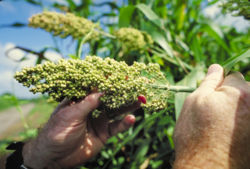Sorghum
| Sorghum subsp. var. | Millet, Sorghum | |||||||||||||||||||||||||||||||||||||||||||||||||||||||
|---|---|---|---|---|---|---|---|---|---|---|---|---|---|---|---|---|---|---|---|---|---|---|---|---|---|---|---|---|---|---|---|---|---|---|---|---|---|---|---|---|---|---|---|---|---|---|---|---|---|---|---|---|---|---|---|---|

|
|
| ||||||||||||||||||||||||||||||||||||||||||||||||||||||
| ||||||||||||||||||||||||||||||||||||||||||||||||||||||||
| Sorghum {{{status}}} Fossil range: {{{fossil_range}}}
| ||||||||||||||||||||||||||||||||||||||||||||||||||||||||||||||||||
|---|---|---|---|---|---|---|---|---|---|---|---|---|---|---|---|---|---|---|---|---|---|---|---|---|---|---|---|---|---|---|---|---|---|---|---|---|---|---|---|---|---|---|---|---|---|---|---|---|---|---|---|---|---|---|---|---|---|---|---|---|---|---|---|---|---|---|
 | ||||||||||||||||||||||||||||||||||||||||||||||||||||||||||||||||||
| Plant Info | ||||||||||||||||||||||||||||||||||||||||||||||||||||||||||||||||||
| ||||||||||||||||||||||||||||||||||||||||||||||||||||||||||||||||||
| Scientific classification | ||||||||||||||||||||||||||||||||||||||||||||||||||||||||||||||||||
| ||||||||||||||||||||||||||||||||||||||||||||||||||||||||||||||||||
| [[{{{diversity_link}}}|Diversity]] | ||||||||||||||||||||||||||||||||||||||||||||||||||||||||||||||||||
| {{{diversity}}} | ||||||||||||||||||||||||||||||||||||||||||||||||||||||||||||||||||
| Binomial name | ||||||||||||||||||||||||||||||||||||||||||||||||||||||||||||||||||
| {{{binomial}}} | ||||||||||||||||||||||||||||||||||||||||||||||||||||||||||||||||||
| Trinomial name | ||||||||||||||||||||||||||||||||||||||||||||||||||||||||||||||||||
| {{{trinomial}}} | ||||||||||||||||||||||||||||||||||||||||||||||||||||||||||||||||||
| Type Species | ||||||||||||||||||||||||||||||||||||||||||||||||||||||||||||||||||
| {{{type_species}}} | ||||||||||||||||||||||||||||||||||||||||||||||||||||||||||||||||||
| Species | ||||||||||||||||||||||||||||||||||||||||||||||||||||||||||||||||||
| About 30 species, see text | ||||||||||||||||||||||||||||||||||||||||||||||||||||||||||||||||||
| [[Image:{{{range_map}}}|{{{range_map_width}}}|]] | ||||||||||||||||||||||||||||||||||||||||||||||||||||||||||||||||||
| Synonyms | ||||||||||||||||||||||||||||||||||||||||||||||||||||||||||||||||||
| {{{synonyms}}} |
Sorghum is a genus of numerous species of grasses, some of which are raised for grain and many of which are utilised as fodder plants either cultivated or as part of pasture. The plants are cultivated in warmer climates worldwide. Species are native to tropical and subtropical regions of all continents in addition to Oceania and Australasia.
For more specific details on commercially exploited Sorghum see commercial sorghum.
Cultivation and uses

Numerous Sorghum species are used for food (as grain and in sorghum syrup or "sorghum molasses"), fodder, and the production of alcoholic beverages. Most species are drought tolerant and heat tolerant and are especially important in arid regions. They form an important component of pastures in many tropical regions. Sorghum species are an important food crop in Africa, Central America, and South Asia, and is the "fifth most important cereal crop grown in the world" [1]. African slaves introduced sorghum into the U.S. in the early 17th century.
Some Sorghum species such as Johnson Grass are important economic and environmental weeds.
The reclaimed stalks of the sorghum plant are use to make a decorative millwork material known as Kirei board.
Some species of Sorghum can contain levels of cyanide and nitrates lethal to grazing animals in the early stages of the plant's growth. Stressed plants, even at later stages of growth, can also contain toxic levels of cyanide.
Species
- Sorghum almum
- Sorghum amplum
- Sorghum angustum
- Sorghum arundinaceum
- Sorghum bicolor
- Sorghum brachypodum
- Sorghum bulbosum
- Sorghum burmahicum
- Sorghum controversum
- Sorghum drummondii
- Sorghum ecarinatum
- Sorghum exstans
- Sorghum grande
- Sorghum halepense
- Sorghum interjectum
- Sorghum intrans
- Sorghum laxiflorum
- Sorghum leiocladum
- Sorghum macrospermum
- Sorghum matarankense
- Sorghum miliaceum
- Sorghum nitidum
- Sorghum plumosum
- Sorghum propinquum
- Sorghum purpureosericeum
- Sorghum stipoideum
- Sorghum timorense
- Sorghum trichocladum
- Sorghum versicolor
- Sorghum virgatum
- Sorghum vulgare
Hybrids
- Sorghum × almum
- Sorghum × drummondii
External links
- FAO Report (1995) "Sorghum and millets in human nutrition"
- FAO "Compendium on post-harvest operations" — Contains discussion on origin, processing and uses of sorghum
- Alternative Field Crops
- ITIS 42106 2002-09-22
- US Grains Council
- ICRISAT
- Grain Sorghum Irrigation
- Sorghum on US Grains Web Site
- National Grain Sorghum Producers
- National Sweet Sorghum Producers and Processors Association
- Sorghum Handbook
- Sorghum Growth Stages
- Sequencing of the Sorghum Genome by Methylation Filtration
- Risk management of cyanide (prussic acid) and nitrates in sorghum crops